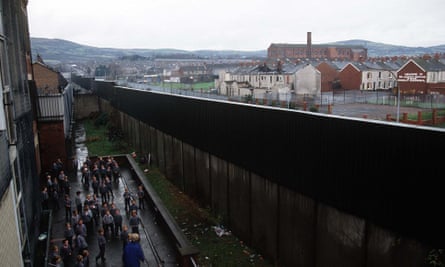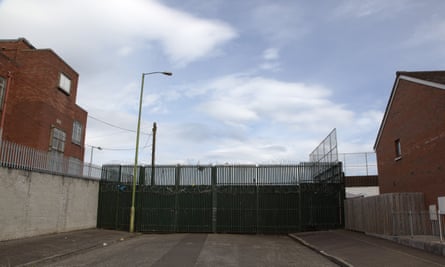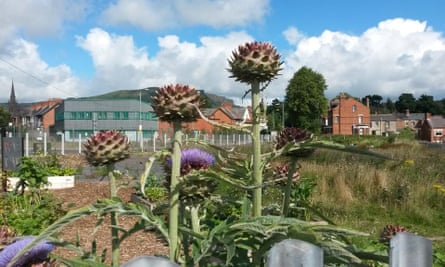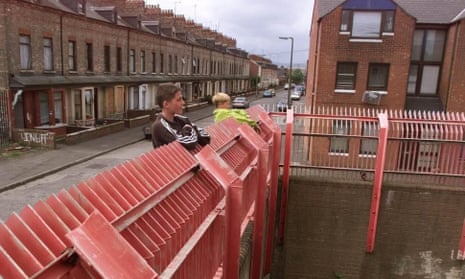In 1971, a secret report by the Northern Irish government criticised the speed with which walls, gates and fences were being constructed in Belfast to separate Catholics and Protestants. The so-called “peace lines”, it said, were creating an “atmosphere of abnormality” in the city. But the Stormont report writers did “not expect any insurmountable difficulty” in bringing down the barricades once the violence had subsumed.
Now, more than 40 years after the British Army constructed the first of those barriers, Belfast is still scarred by them: corrugated iron fences, some as high as 18ft, topped with barbed wire. Defensive architecture, it turns out, is far easier to erect than tear down. The city’s gates and walls have become “part of the built environment”, according to Jonny Byrne, a lecturer in politics at the University of Ulster. “The Berlin Wall had to come down for Berlin to be normalised. We have normalised Belfast without taking down the walls.”
Indeed, Belfast’s defensive walls are arguably the most famous of those many “divided cities” riven by ethnic conflict. When I was in Mitrovica, Kosovo, another divided city, ethnic Serbs informed me what a putative peace-building trip to Northern Ireland had actually taught them. “We need bigger walls,” one said.
In fact, the number of barricades in Belfast has actually increased since the Good Friday Agreement brought the Northern Irish conflict to an end in 1998. A 2012 study found almost 100 walls, fences, gates and roads forming “interfaces” between communities across the city.
It can seem baffling to outsiders. Why does Belfast still cleave to its walls? In 2008, then New York mayor Michael Bloomberg said that bringing down the barriers would open “floodgates of private investment”. Northern Ireland’s power-sharing government has vowed to remove all the peace walls by 2023.

Yet the scale – if not the impossibility – of that bold promise is all too apparent in North Belfast, a four-mile-squared patchwork of sectarian enclaves and divided loyalties that is home to almost half of the city’s peace walls. North Belfast witnessed some of the worst violence: a fifth of the more than 3,000 people killed during the Troubles died among these streets, where kerbstones alternate between nationalist green and unionist red, white and blue. Most people live on streets that are 90% Catholic or Protestant. The neighbourhood is also among the most economically deprived areas in Northern Ireland. Unlike the bustling city centre, there are no upmarket bars or expensive cafes serving flat whites.
“People say that when the walls come down, the investment will flow in. But they can’t even put in light bulbs here,” says Rab McCallum, a republican ex-prisoner who works for the North Belfast Interface Network (NBIN).
NBIN has been working for the better part of a decade out of a low-ceilinged office in a red-brick terrace near Cliftonville FC’s ground, Solitude. The group has studied peace walls, created an interactive map of them, and worked tirelessly to improve communication and prevent conflict across the “interface”, the city jargon for where Catholic and Protestant communities abut. McCallum and the small team are in touch by telephone with community workers on the loyalist side of the peace line, working constantly to defuse tensions, especially during the contentious summer marching season.
There have been some successes. In 2011, a “peace gate” was installed in the 3.5-meter-high corrugated iron fence that cuts through the tidy Victorian grounds of Alexandra Park. The foundations of that fence had been laid on 1 September 1994 – the day after the Provisional IRA announced a “complete cessation of military operations”.

Since opening, that “peace gate” has operated largely without incident. On a quiet weekday afternoon, dog walkers stroll from the Tiger’s Bay end, where Northern Irish flags fly from lampposts, to the republican Antrim Road, and vice versa. Nearby, a car turns down Newington Street. Until a few years ago, this was impossible: a steel gate, erected in the late 1980s following a spate of sectarian murders, barred the entrance to the nondescript row of terrace houses. Now the gate is open for most of the daytime: the hours have recently been extended.
Numerous other attempts to break down North Belfast’s defensive architecture, however, have run into the sand. Despite residents on both sides agreeing to a peace gate in the metal barrier that divides Flax Street, road authorities have refused to introduce expensive traffic-calming measures.
Even though segregation is estimated to cost Stormont £1.5bn a year, most of the funding for such “community relations” work comes from international donors, who are in the process of pulling out of Northern Ireland. “There is no momentum, there is no resources and the government haven’t provided a vision of a united community. They haven’t sold the benefits and opportunities” of taking down the peace walls, says McCallum. “We are in a situation where deadlines are constantly being put back, quite often because of an inability to secure the resources required.”
The peace walls were constructed, sometimes overnight, under anti-terrorism legislation. No formal mechanism exists for dismantling them. Lack of clear ownership – and legislative control – is compounded by the absence of clear guidelines for community agreement. A single resident’s opposition can be enough to maintain the status quo. “One voice can veto change for the many,” says NBIN’s Brendan Clarke.

Stormont is dominated by once-sworn enemies Sinn Fein and the Democratic Unionist Party (DUP). There is little agreement about how to deal with the past, including peace walls. “There is no political need to build consensus,” says Norman Hamilton, a Presbyterian minister and member of the Community Relations Council.
The result is that, although the violence has largely abated, issues about the past – and the future – continue to dog Northern Irish politics.
Tensions between the parties threatened to bring down Stormont this summer, including the involvement of IRA members in the August murder of onetime republican gunman Kevin McGuigan. There have been ongoing anxieties over parades, with occasional incidents of violence. As I was sitting in the NBIN office, an email pinged into Clarke’s inbox. “There’s been a pipe bomb on the Oldpark Road.”
About a mile away, in West Belfast, on the opposite side of the peace line, shoppers on the Shankill Road pass storefronts selling mugs emblazoned with the Queen’s face. A mural depicts Belfast in its industrial heyday: Samson and Goliath, the iconic yellow cranes at Harland and Wolff. A little further down the street is another mural, this time in darker colours: two men bow their heads in honour of slain loyalist paramilitaries.
For four decades, an imposing, 800-metre-long, multilevel barrier has divided the loyalist Shankill and republican Falls Road. “The British Army started putting barbed wire to separate communities, then it was corrugated iron to separate communities, then brick walls that were added to and added to, even after the Good Friday Agreement,” says Ian McLaughlin of the Lower Shankill Community Association.

At the same time as barriers were going up between Catholics and Protestants, the decrepit terrace houses of the Shankill were being torn down. In 1961, more than 70,000 people lived in the area; now it’s fewer than 25,000. Most left for loyalist estates that ring the outskirts of the city. Similar movements took place across working-class Belfast. The result is that demand for housing is, in general, far higher in Catholic areas than Protestant.
“Catholics see peace walls as a problem to their community developing. For Protestants, peace walls protect their way of life, their bonfires, their flags,” says Byrne. “The question is, how do we create the conditions in which Protestants don’t see the removal of the wall as a threat to their existence as a community?”
McLaughlin, too, would like to see all the peace walls removed. “But reaching that point is a huge journey,” he says, particularly for Protestants who fear that their areas could go from orange to green almost overnight if the barriers were gone. Meanwhile, many unionist politicians fear that building new homes in Catholic neighbourhoods could dilute their electoral base.
“The difficulty in any peace wall conversation is that a lot of the initial conversations revolve around a sense of loss. What will I lose?’ asks McLaughlin, who has worked with republicans on the Falls area to improve access across the peace line.
The answer to Belfast’s peace wall conundrum lies in regeneration, says McLaughlin. A new housing development in the Shankill area is going up, after an agreement was reached with the local community. “Our core business at one time was peace-building, but now we have a dual approach – regenerating our community and building relations with our neighbours.”

But macro-political tensions can impinge on attempts to build relationships at street level. At Skegoneill Avenue in North Belfast, loyalist paramilitary flags fly from lamp-posts, even though the streets are mostly mixed and even include Belfast’s synagogue. In the shadow of an Ulster Volunteer Force, lettuce and spinach sprout in Peas Park, a community garden created by local residents. Chickens cluck happily beside a shipping container that has been turned into a shop.
“People just independently started doing stuff,” says Callie Persic, an ebullient American who came to Belfast 20 years ago for her PhD in anthropology and stayed. The garden is particularly popular with young people. In September, there is a harvest day with food, music and face painting.
Peas Park, however, has not escaped Belfast territoriality. Earlier this summer, a fence was erected around the garden. “People have been saying to us, ‘You must feel safer now there is a fence,’” says Persic. “But I felt like, why are we putting up a gate at an interface?”
Follow Guardian Cities on Twitter and Facebook to join the discussion

Comments (…)
Sign in or create your Guardian account to join the discussion